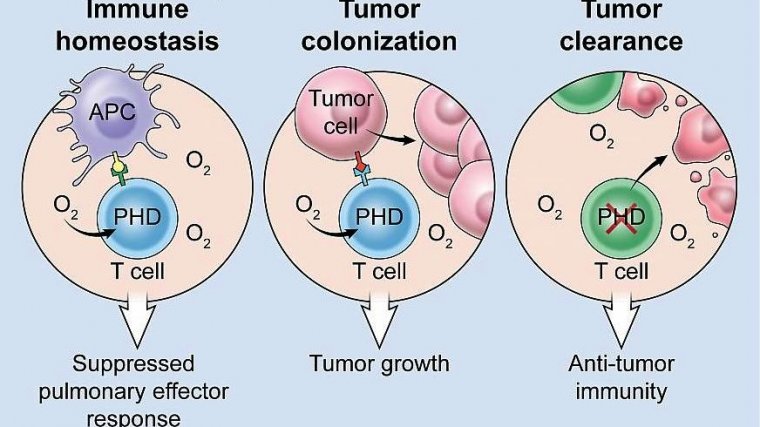| Health / Health News |
Oxygen can impair cancer immunotherapy in mice
NIH | SEPTEMBER 6, 2016
Researchers have identified a mechanism in mice by which anticancer immune responses are inhibited within the lungs, a common site of metastasis for many cancers. This mechanism involves oxygen inhibition of the anticancer activity of T cells. Inhibiting the oxygen-sensing capability of immune cells, either genetically or pharmacologically, prevented lung metastasis.

This panel shows how the PHD protein, depicted as a sphere in the three bottom panels, suppresses lung response, tumor growth, and anti-tumor immunity. ![]()
The researchers discovered that T cells, a type of immune cell, contain a group of oxygen-sensing proteins which act to limit inflammation within the lungs. This new research shows, however, that oxygen also suppresses the anticancer activity of T cells, thereby permitting cancer cells that have spread to the lungs to escape immune attack and establish metastatic colonies.
The research team discovered that oxygen-sensing proteins, called prolyl hydroxylase domain (PHD) proteins, act within T cells to prevent overly strong immune responses to harmless particles that frequently enter the lung. This protective mechanism also allows circulating cancer cells to get a foothold in the lung.
Specifically, the researchers found that PHD proteins promote the development of regulatory T cells, a type of T cell that suppresses the activity of other parts of the immune system. They also found that PHD proteins limit the development of inflammatory T cells and restrain their ability to produce molecules involved in cancer killing.
Given their finding that PHD proteins suppress the inflammatory immune response in the lung, the researchers wondered whether inhibiting them might improve the efficacy of adoptive cell transfer, a type of immunotherapy that harnesses the ability of a patient’s own T cells to recognize and attack cancer.
In adoptive cell transfer, T cells are extracted from a patient’s tumor tissue, expanded to great numbers in the laboratory, and then administered intravenously into the patient along with a T-cell growth factor, with hopes that these cells will return to sites of cancer and eliminate it.
For these experiments, the research team expanded the antitumor T cells in the presence of a drug called dimethyloxaloylglycine (DMOG), which blocks the activity of PHD proteins. In the lab, the drug treatment improved the cancer-killing properties of the T cells and when administered to mice with established metastatic cancer, the drug-treated T cells were far better at eliminating cancer than untreated T cells. DMOG treatment has also been found to improve the cancer-killing properties of human T cells in other studies.
YOU MAY ALSO LIKE

